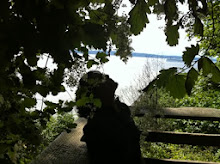View across the Thames looking towards Greenwich.
What it looked like a few weeks back. One can see not just Greenwich Park and the Observatory in the background but much beyond almost to the outskirts of London (yes, if only I had posted a high res picture).
Looking towards the City that is the one square mile that has been the financial centre of London since Medieval times.
Looking towards the City on a clear day (10 days back). Seen here are not just the iconic buildings (Gherkin et.al) but also the red train waiting at the station.
This is Canary Wharf. Home to all the big, bad financial institutions– banks, trading companies, rating agencies– you name it– they are all there.
Canary Wharf and the City and everything else on a clearer day.
London fog also known as the pea souper was a mixture of smoke from millions of chimneys and the mists and fogs of the Thames valley. These days the fog is predominantly mist, it still has traces of smog though nothing compared to what it was like in the late 19th century, for chimneys and chimney sweeps have long since been consigned to the pages of history. Though considering that they have been replaced by millions of cars I wonder how much has the air quality changed?
Here's Charles Dickens describing what it must have been like in the days when soot and sulphur dioxide filled mist descended upon London.
"Fog everywhere. Fog up the river, where it flows
among green aits and meadows; fog down the river, where it rolls defiled
among the tiers of shipping and the waterside pollutions of a great
(and dirty) city. Fog on the Essex marshes, fog on the Kentish heights.
Fog creeping into the cabooses of collier-brigs; fog lying out on the
yards, and hovering in the rigging of great ships; fog drooping on the
gunwales of barges and small boats. Fog in the eyes and throats of
ancient Greenwich pensioners, wheezing by the firesides of their wards;
fog in the stem and bowl of the afternoon pipe of the wrathful skipper,
down in his close cabin; fog cruelly pinching the toes and fingers of
his shivering little ’prentice boy on deck. Chance people on the bridges
peeping over the parapets into a nether sky of fog, with fog all round
them, as if they were up in a balloon, and hanging in the misty clouds.
Gas looming through the fog in divers places in the streets, much as the sun may, from the spongey fields, be seen to loom by husbandman and ploughboy. Most of the shops lighted two hours before their time — as the gas seems to know, for it has a haggard and unwilling look."
Gas looming through the fog in divers places in the streets, much as the sun may, from the spongey fields, be seen to loom by husbandman and ploughboy. Most of the shops lighted two hours before their time — as the gas seems to know, for it has a haggard and unwilling look."
―
Charles Dickens,
Bleak House (chapter 3)
And here is Dickens Jr. (son of Charles Dickens also known as Charles Dickens) defining the fog in
'Dickens’s dictionary of London, 1892-1893 (fourteenth year): an unconventional handbook.' for any and all enthusiasts of Victorian London.
'Dickens’s dictionary of London, 1892-1893 (fourteenth year): an unconventional handbook.' for any and all enthusiasts of Victorian London.
“Fogs are, no doubt, not peculiar to London. Even
Paris itself can occasionally turn out very respectable work in this
way, and the American visitor to England will very probably think, in
passing the banks of Newfoundland, that he has very little to learn on
the subject of fog. But what Mr. Guppy called “a London
particular,” and what is more usually known to the natives as “a
pea-souper,” will very speedily dispel any little hallucination of this
sort. As the east wind brings up the exhalations of the
Essex and Kentish marshes, and as the damp-laden winter air prevents the
dispersion of the partly consumed carbon from hundreds of thousands of
chimneys, the strangest atmospheric compound known to science fills the
valley of the Thames. At such times almost all the senses have their share of trouble. Not
only does a strange and worse than Cimmerian darkness hide familiar
landmarks from sight, but the taste and smell are offended by an
unhallowed compound of flavours, and all things become greasy and clammy
to the touch. During the continuance of a real London fog –
which may be black, or grey, or more probably orange-coloured – the
happiest man is he who can stay at home."
More on Victorian London can be found here.
More on Victorian London can be found here.
























2 comments:
Very interesting post with lovely photos of London.
I'm an enamoured of London and I think London always looks perfect, even with some fog. Still, air quality is a worrying issue, nevertheless!
Thank you, Irenita. Yes, London is a very interesting place to be in. And that makes it immensely photogenic (though some Londoners will perhaps be quick to list its many faults...the skyline, the weather etc. etc.).
Post a Comment